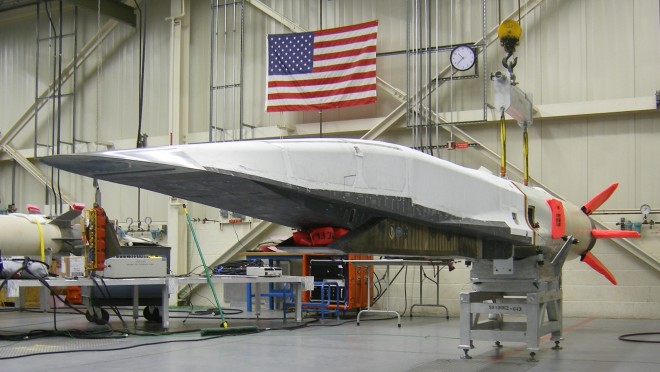On Tuesday, an Air Force B-52 bomber is scheduled to take off from Edwards Air Force Base in California. Under its wing will be the closest thing in the world to a hypersonic missile. The plane will soar over the Pacific Ocean, ascend to 50,000 feet, and then let loose the 26-foot-long experimental missile. If all goes well for the military’s flight test, the missile will accelerate past Mach 5, rush more than 300 miles in less than five minutes, and usher in a new chapter in high-speed warfare. If it fails — and the last two tests of this X-51A Waverider have fallen short — then the Pentagon will have sent something on the order of $300 million to the bottom of the Pacific.

The U.S. military is scrambling to find a method for striking targets hundreds, even thousands, of miles away in a matter of minutes. But the Pentagon’s options for this so-called “prompt global strike” mission are all problematic. It can retrofit once-nuclear Intercontinental Ballistic Missiles, or ICBMs, with conventional warheads. Such launches would resemble atomic first-strikes, though, and could trigger World War III. Option two is to go with something like the X-51A — a cruise missile than can travel seven or eight times faster than anything presently in the American arsenal. Mastering the aeronautical engineering, materials science, and fluid dynamics needed to build such a hypersonic weapon have not been easy, however.
The X-51A’s supersonic combustion ramjet engine collects air from the atmosphere, mixes it with a mist of jet fuel, and then lights the combination on fire. In its first flight test in 2010, it performed pretty well, flying for more than three minutes before a seal broke. (Video of that test is below.) The second flight, however, lasted just a few seconds. The Waverider generated an unexpected set of shockwaves, creating an overpressure in front of its engine. “Combustion stopped, and everyone had a bad day,” says Dr. Mark Lewis, the former chief scientist of the Air Force and one of the world’s leading authorities on hypersonic flight.
Changing the timing of how fuel is injected into the engine should change the pattern of shockwaves generated by the X-51A. That should allow the missile to fly for a full five minutes, Lewis and his colleagues hope. If things work out, the U.S. military could have the beginning of a working candidate for its “global strikes.”
The Air Force is already working on a follow-on program, dubbed the “High Speed Strike Weapon,” to transform something like the X-51A from an expensive experiment into a real-life tool of war. Its success could depend on Tuesday’s test. There are the materials for a fourth flight test of the X-51A; the budget and the will to spend it may be drained by another early flame-out, however.
“The important thing in this test is that the supersonic combustion ramjet engine runs for hundreds of seconds,” Lewis tells Danger Room. “If we have that, we have a practical engine to power a high-speed weapon.”
The Pentagon has one more option for global strike — but it may be even more technically difficult than the X-51A. It puts a hypersonic glider on top of a rocket, sends the combination to the edge of space, and then has the reentry vehicle scream down to Earth at 20 times the speed of sound. Last August, the second of two Darpa test vehicles using this approach was lost over the Pacific. But the agency is determined to try again. Darpa says it can have a Mach 20 aircraft ready to go in four years. The first meeting for potential researchers on this program is Tuesday — just when that B-52 will be taking off from Edwards, ready to unleash its hypersonic payload.


Poof! FAIL!